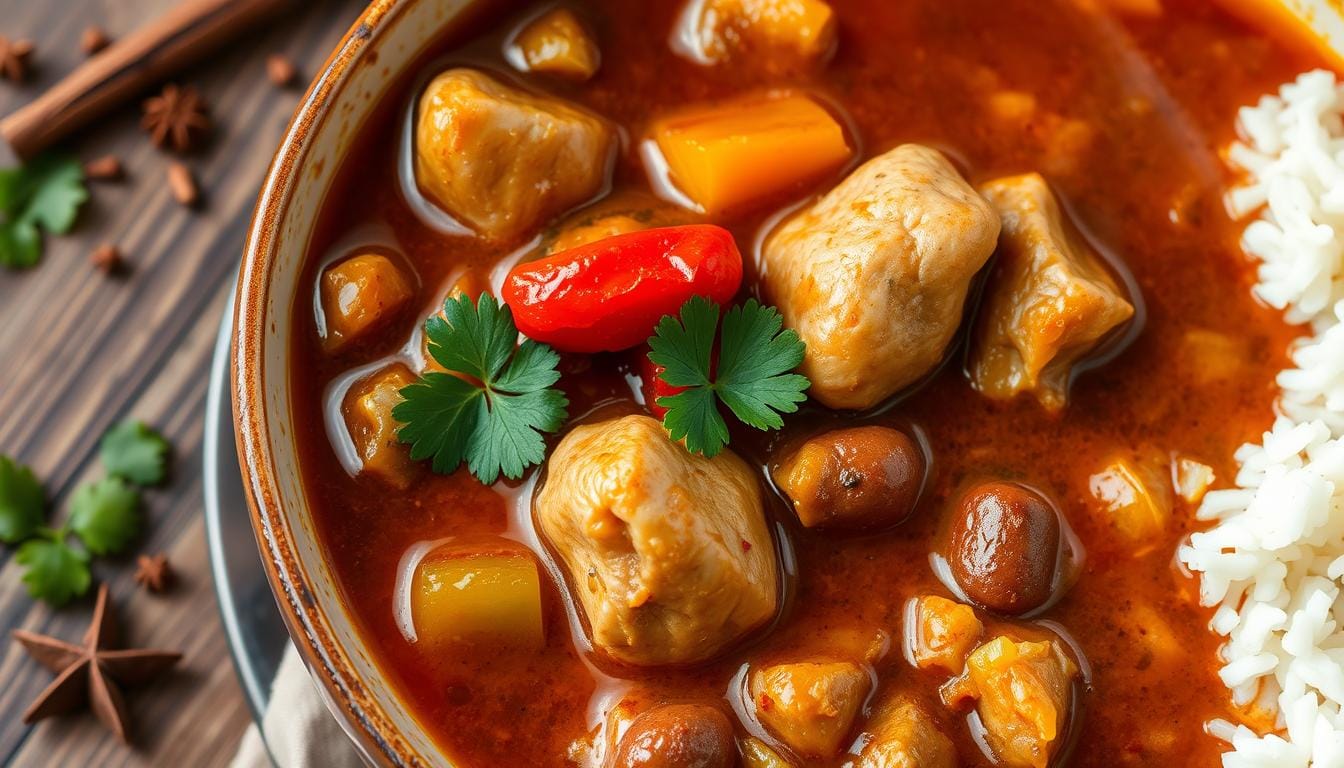Gumbo: The Ultimate Guide to This Beloved Cajun Stew
When gumbo’s rich aroma fills your kitchen, you feel like you’re in Louisiana. It’s more than a meal; it’s a journey through generations of traditions. Gumbo is a blend of cultures, family recipes, and Louisiana’s lively spirit.
Gumbo is Louisiana’s official state food, showing off the state’s rich culinary history. It’s loved in New Orleans restaurants and family kitchens alike. It’s a dish that tells a story with every bite, perfect for both seasoned cooks and curious foodies.
Every gumbo is special, showing the creativity and heart of its maker. Making it takes about 2 hours, with the roux needing 45 minutes of careful cooking. It’s an art that needs patience, skill, and passion.
Table of Contents
Key Takeaways
- Gumbo represents the heart of Louisiana cooking
- Preparation requires approximately 2 hours of dedicated cooking
- Each Cajun Gumbo recipe tells a unique cultural story
- The dish combines multiple culinary influences
- Proper roux-making is crucial to authentic Cajun Gumbo flavor
Understanding the Rich Heritage of Cajun Gumbo
Gumbo is more than a meal in Louisiana; it’s a story of cultural fusion and tradition. This iconic dish reflects survival, creativity, and multicultural influence over generations.
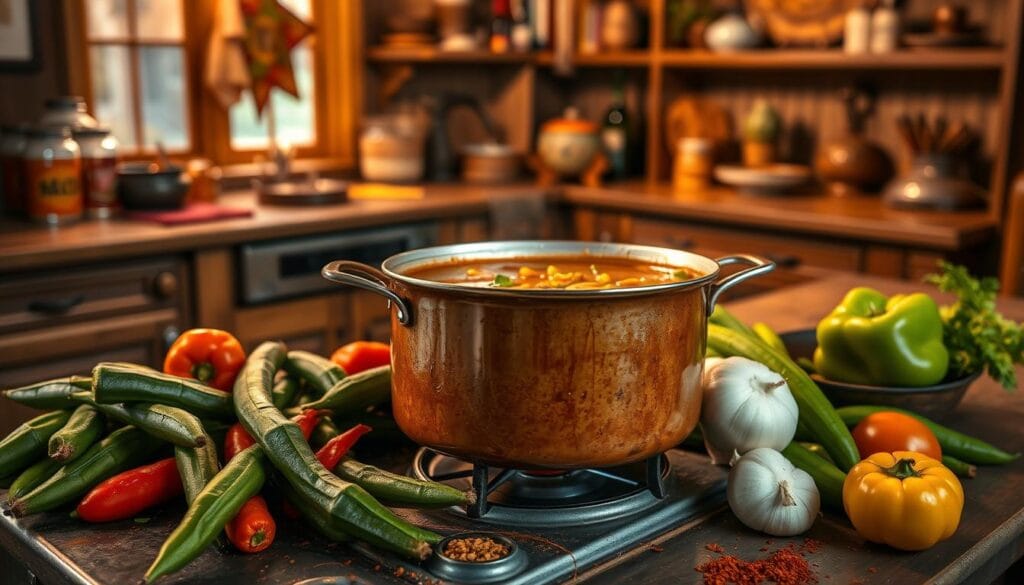
The origins of Cajun Gumbo are fascinating. Creole cuisine comes from African, Native American, French, and Spanish influences. Each group added something special to this dish.
Cultural Significance in Louisiana Cuisine
Gumbo shows the resilience and adaptability of Louisiana’s diverse communities. Key cultural contributions include:
- West African slaves introducing okra
- Choctaw Native Americans developing filé powder
- French settlers bringing roux-making techniques
- Spanish settlers adding their spice and flavor profiles
Evolution from Creole to Modern Variations
The evolution of gumbo shows the dynamic nature of Louisiana cooking. From traditional recipes to modern twists, the dish keeps its core identity.
| Gumbo Type | Key Characteristics |
|---|---|
| Creole Cajun Gumbo | Tomato-based, seafood-rich |
| Cajun Gumbo | Darker roux, meat-focused |
| Modern Fusion | Experimental ingredients, global influences |
Regional Differences in Preparation
Each Louisiana region adds its own twist to gumbo, showing its versatility. From seafood to meat-based recipes, Cajun Gumbo celebrates culinary creativity.
“Gumbo is not just a dish, it’s a celebration of Louisiana’s rich cultural tapestry.” – Louisiana Culinary Historians
Essential Ingredients That Make a Traditional Gumbo
Making a real Cajun Gumbo needs the right ingredients. These add depth, flavor, and tradition to this Cajun favorite. At its core, the holy trinity of onions, celery, and bell peppers is key. They form the base of Louisiana’s flavor.
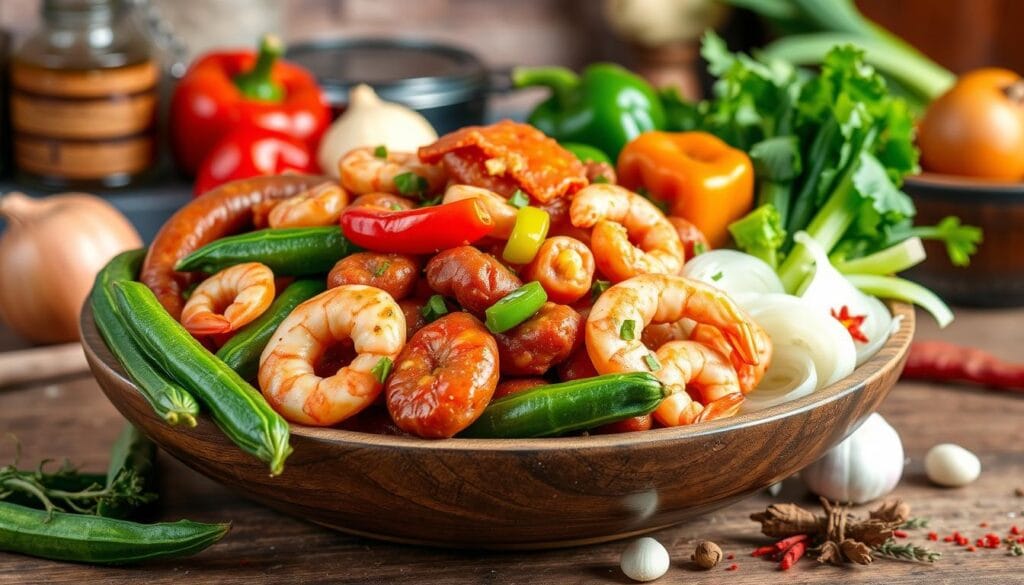
Gumbo’s protein choices are varied and exciting. Andouille sausage is a classic, adding smoky, spicy notes. Traditional recipes often include:
- Chicken
- Seafood (shrimp, crab)
- Smoked sausage
- Ham
Okra is crucial in Cajun Gumbo, acting as both thickener and flavor booster. Sliced okra adds a unique texture and helps achieve the dish’s signature consistency.
“A great Cajun Gumbo is a symphony of flavors, with each ingredient playing its part perfectly.” – Cajun Cooking Tradition
The seasoning blend is also vital. A typical Cajun spice mix might include:
- Thyme
- Oregano
- Cayenne pepper
- Salt
- Black pepper
Whether it’s a meat or seafood gumbo, the goal is to balance these ingredients. This creates a rich, complex flavor that tells Louisiana’s culinary story.
Mastering the Art of Roux Making
The heart of any authentic Cajun Gumbo recipe is its roux. This magical mix of fat and flour turns into a flavor-packed base. It’s what makes the dish special. Learning about roux can take your cooking to the next level.
Making the perfect roux takes patience and skill. It’s made with equal parts fat and flour, usually ¼ cup of each. This mix thickens about 2 cups of liquid. Cook it slowly, stirring constantly to avoid burning.
Different Types of Roux Colors
Roux has several stages, each with its own flavor and character:
- White Roux: Best for creamy dishes and chowders
- Blonde Roux: Perfect for lighter gravies and mac and cheese
- Peanut Butter Roux: Ideal for light stews
- Light Brown Roux: Great for Cajun stews
- Medium Brown Roux: Deep copper color for hearty dishes
- Dark Brown Roux: Preferred for traditional Cajun Gumbo
Common Roux-Making Mistakes to Avoid
Roux-making can be tricky. Here are common mistakes to avoid:
- Cooking at too high a temperature
- Not stirring constantly
- Burning the mixture
- Using the wrong type of fat
Traditional vs Modern Roux Techniques
| Traditional Method | Modern Technique |
|---|---|
| Stovetop cooking | Oven-based roux |
| Constant stirring | Less frequent monitoring |
| Butter or lard | Vegetable oils and alternative fats |
“The secret to a great roux is patience and attention to detail.” – Louisiana Cooking Wisdom
Pro tip: The Maillard reaction during roux-making creates hundreds of new flavor compounds. This gives your gumbo its signature depth and complexity. Take your time, watch the color carefully, and you’ll create a roux that’s the talk of any dinner table.
The Holy Trinity: Foundation of Flavor
In Cajun cooking, the holy trinity is key. It turns simple dishes into amazing meals. Onions, bell peppers, and celery are the base for many Louisiana recipes, especially Cajun Gumbo.
“The holy trinity is not just an ingredient mix, it’s a cultural narrative stirred into every pot.” – Cajun Cooking Tradition
To truly understand the holy trinity, knowing its parts is not enough. The right mix is crucial. Traditionally, Cajun chefs mix:
- 3 parts onions
- 2 parts celery
- 1 part bell pepper
While green bell peppers are classic, chefs now use red or yellow too. This adds new flavors. The holy trinity’s flexibility lets chefs get creative while keeping its essence.
| Culinary Tradition | Holy Trinity Variant | Key Ingredients |
|---|---|---|
| Cajun | Classic Holy Trinity | Onions, Celery, Green Bell Peppers |
| French | Mirepoix | Onions, Carrots, Celery |
| Spanish | Sofrito | Onions, Garlic, Peppers |
The holy trinity’s history is rich in Louisiana’s food scene. It comes from French, Spanish, and West African traditions. This mix is more than cooking—it’s a tribute to cultural heritage.
Protein Choices: From Andouille to Seafood
Gumbo is a dish full of protein options, making it a culinary adventure. Each protein adds its own flavors and textures, making the meal unforgettable.
Meat-Based Gumbo Delights
Meat-based gumbos are a hit, especially with andouille sausage and chicken. The spicy andouille sausage adds a smoky flavor that pairs well with tender chicken. Recipes often mix these for a hearty dish.
- Andouille sausage: Brings intense spice and depth
- Chicken: Offers tender, mild protein base
- Smoked sausage: Adds extra layer of complexity
Seafood Gumbo Combinations
Seafood gumbo is another great variation of this stew. Ingredients like shrimp, crab, and oysters make it a luxurious dish. It captures the essence of Louisiana’s coast.
| Seafood Type | Flavor Profile | Cooking Recommendation |
|---|---|---|
| Shrimp | Sweet, delicate | Add last 5-7 minutes |
| Crab | Rich, buttery | Pre-cooked or fresh |
| Oysters | Briny, complex | Add near end of cooking |
Vegetarian Gumbo Adaptations
Vegetarian gumbo is a great option for those who don’t eat meat. Use vegetables, legumes, and meat substitutes for a tasty, healthy dish.
“Gumbo is not just a meal, it’s a celebration of flavor and creativity!” – Louisiana Chef
Gumbo has something for everyone, whether you like meat, seafood, or vegetables. The secret is in the spices, quality ingredients, and passion for cooking.
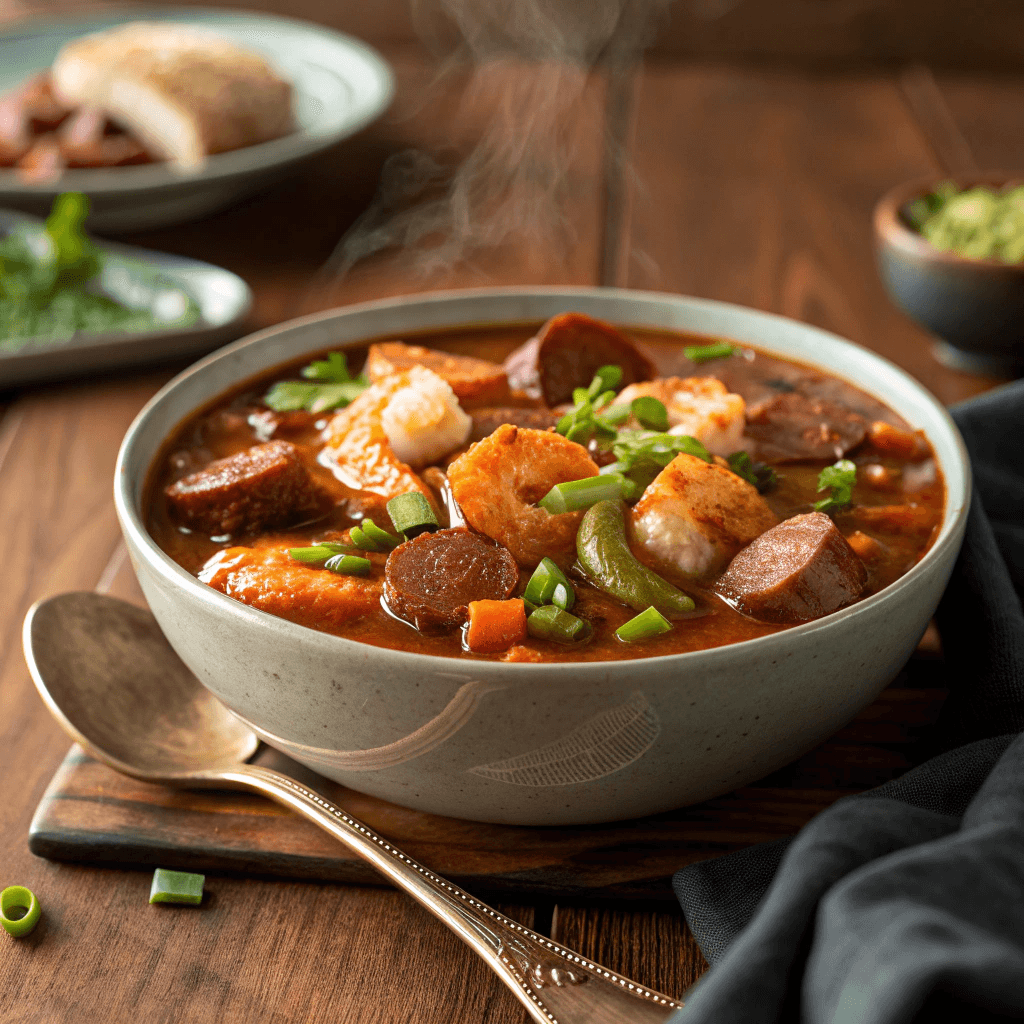
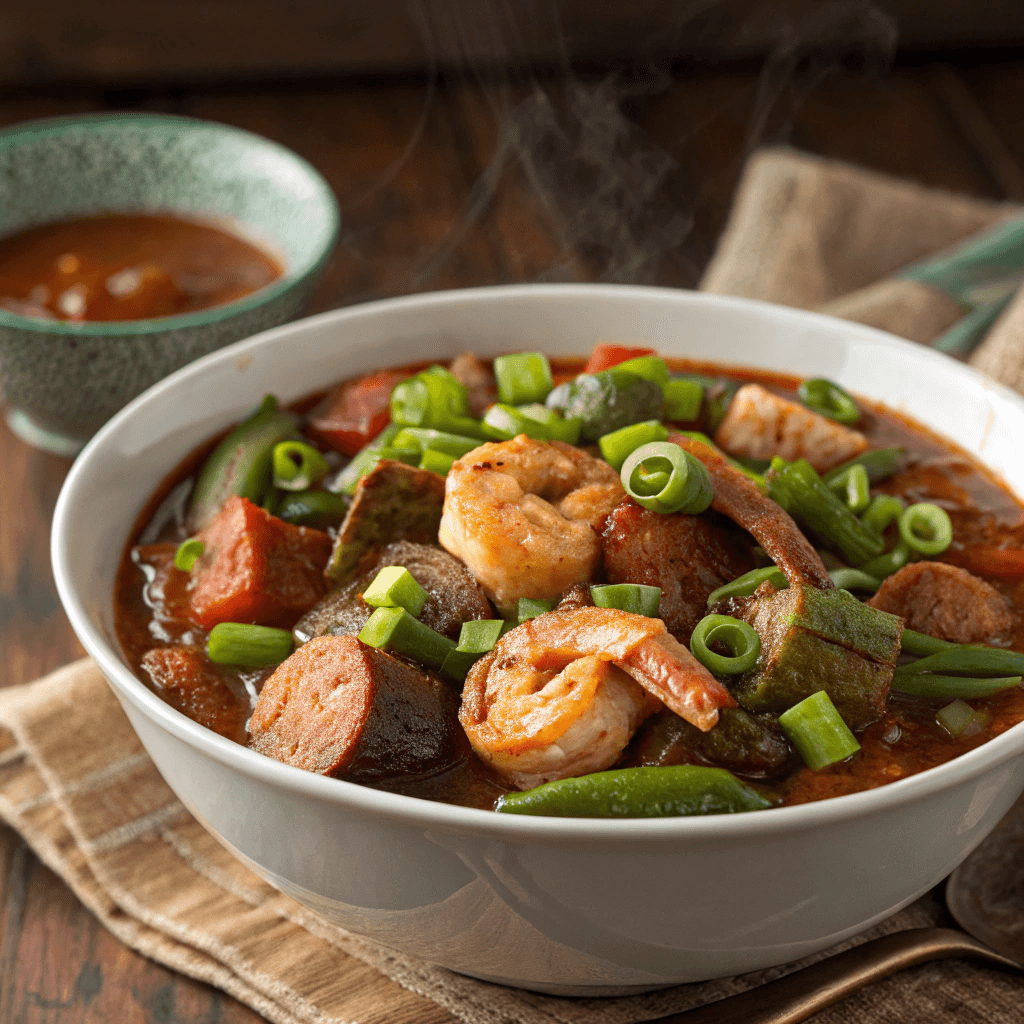
Thickeners and Seasonings: Okra and Filé Powder
Gumbo’s unique texture and depth come from special thickeners. Okra and filé powder are the most traditional ingredients. They create a rich, hearty stew that captures the essence of Cajun cuisine.
Understanding okra’s role in Cajun Gumbo is crucial. This green vegetable does more than add flavor. It acts as a natural thickener.
When cooked over high heat or used in a frozen state, okra minimizes its sliminess. This enhances the dish’s overall texture.
- Okra provides natural mucilage for thickening
- Best used in 1 cup quantities per serving
- Sauté for 10-15 minutes to reduce slickness
Filé powder brings another dimension to Cajun Gumbo. It’s made from ground sassafra leaves, offering a unique flavor. Chefs recommend adding filé powder sparingly – typically a tablespoon.
It’s best to add filé powder after removing the pot from heat. This prevents a stringy texture.
| Thickener | Usage Recommendation | Flavor Profile |
|---|---|---|
| Okra | 1 cup per serving | Mild, slightly grassy |
| Filé Powder | 1 tablespoon at end of cooking | Earthy, root-like |
Professional Cajun Gumbo makers rarely combine okra and filé powder. Choose one thickener to maintain the authentic flavor and texture. Experiment with these traditional seasonings to create a memorable Louisiana stew.
“In Cajun cooking, okra and filé powder are more than ingredients – they’re a culinary tradition passed down through generations.”
Step-by-Step Cooking Process
Making the perfect gumbo takes patience and care. This guide will help you make a delicious gumbo, just like Louisiana’s.
Preparation Techniques
Start by getting your ingredients and tools ready. A good gumbo begins with mise en place – having everything measured and ready.
- Chop vegetables evenly for cooking
- Prepare proteins ahead of time
- Measure out spices and seasonings
- Make sure your pot and utensils are clean and ready
Cooking Times and Temperatures
Timing is key when making Cajun Gumbo. Each step needs the right temperature and time.
| Cooking Stage | Time | Temperature |
|---|---|---|
| Roux Making | 5-15 minutes | Medium heat |
| Vegetable Sautéing | 7-9 minutes | Medium heat |
| Simmering | 20-30 minutes | Low heat |
| Shrimp Cooking | 3-4 minutes | Low heat |
Storage and Reheating Methods
Proper storage keeps your Cajun Gumbotasty for days. Refrigerate in an airtight container for up to 2 days or freeze for up to 3 months.
“A great gumbo often tastes better the next day, as flavors continue to develop and meld together.” – Louisiana Cooking Tradition
When reheating, use low heat and stir often to avoid scorching. Add chicken broth if it’s too thick.
- Reheat slowly in a pot on the stove
- Stir frequently to prevent burning
- Add extra broth if needed
- Serve over fresh rice
Serving Traditions and Accompaniments
When serving gumbo, traditional Louisiana cooking offers a delightful array of accompaniments. These sides elevate this iconic dish. The perfect Cajun Gumbo experience goes beyond the stew itself, encompassing carefully chosen sides that complement its rich flavors.
Rice is the foundational accompaniment for gumbo. White rice provides a neutral base that beautifully absorbs the stew’s complex flavors. A perfectly cooked scoop of rice transforms your gumbo into a complete meal.
- White rice (15-20 minutes preparation)
- Potato salad (30 minutes preparation)
- French bread (10 minutes preparation)
- Cornbread (30 minutes preparation)
Beyond rice, authentic Louisiana cooking suggests several traditional side dishes that pair wonderfully with gumbo:
| Side Dish | Flavor Profile | Preparation Time |
|---|---|---|
| Potato Salad | Creamy, tangy | 30 minutes |
| Fried Okra | Crispy, spicy | 20 minutes |
| Cornbread | Sweet, hearty | 30 minutes |
“In Louisiana, a gumbo isn’t just a meal—it’s a celebration of flavor and tradition.”
For those seeking additional accompaniments, consider serving sweet potatoes, collard greens, or a cold beer. Each side dish adds its unique character to the gumbo experience. This creates a memorable culinary journey through Louisiana’s rich food culture.
Conclusion
Gumbo is more than a recipe; it’s a journey into Creole cuisine. It’s known for its flexibility, with each family adding their own twist. This makes gumbo a beloved dish in Louisiana.
Whether you make a seafood gumbo, a chicken and sausage version, or a vegetarian option, it’s all good. The roux can be dark or light, depending on your preference. The most important thing is to have fun and make it your own.
Gumbo celebrates the diversity of Louisiana’s food culture. By adding your own touches, like andouille sausage or secret ingredients, you join a long tradition. Your gumbo is a way to connect with Louisiana’s rich culinary heritage.
So, get ready to start your gumbo adventure. Trust your taste and respect the traditions. But don’t hesitate to put your own spin on it. Every gumbo has a story to tell, and now it’s your turn.
FAQ
What exactly is gumbo?
What makes a traditional gumbo different from other stews?
How long does it take to make authentic gumbo?
Can I make gumbo without seafood?
What’s the difference between Creole and Cajun gumbo?
How do I prevent my roux from burning?
What is filé powder, and where does it come from?
How long can I store leftover gumbo?
What’s the best rice to serve with gumbo?
Can I make gumbo in advance?
How Was It?
There are no reviews yet. Be the first one to write one.

